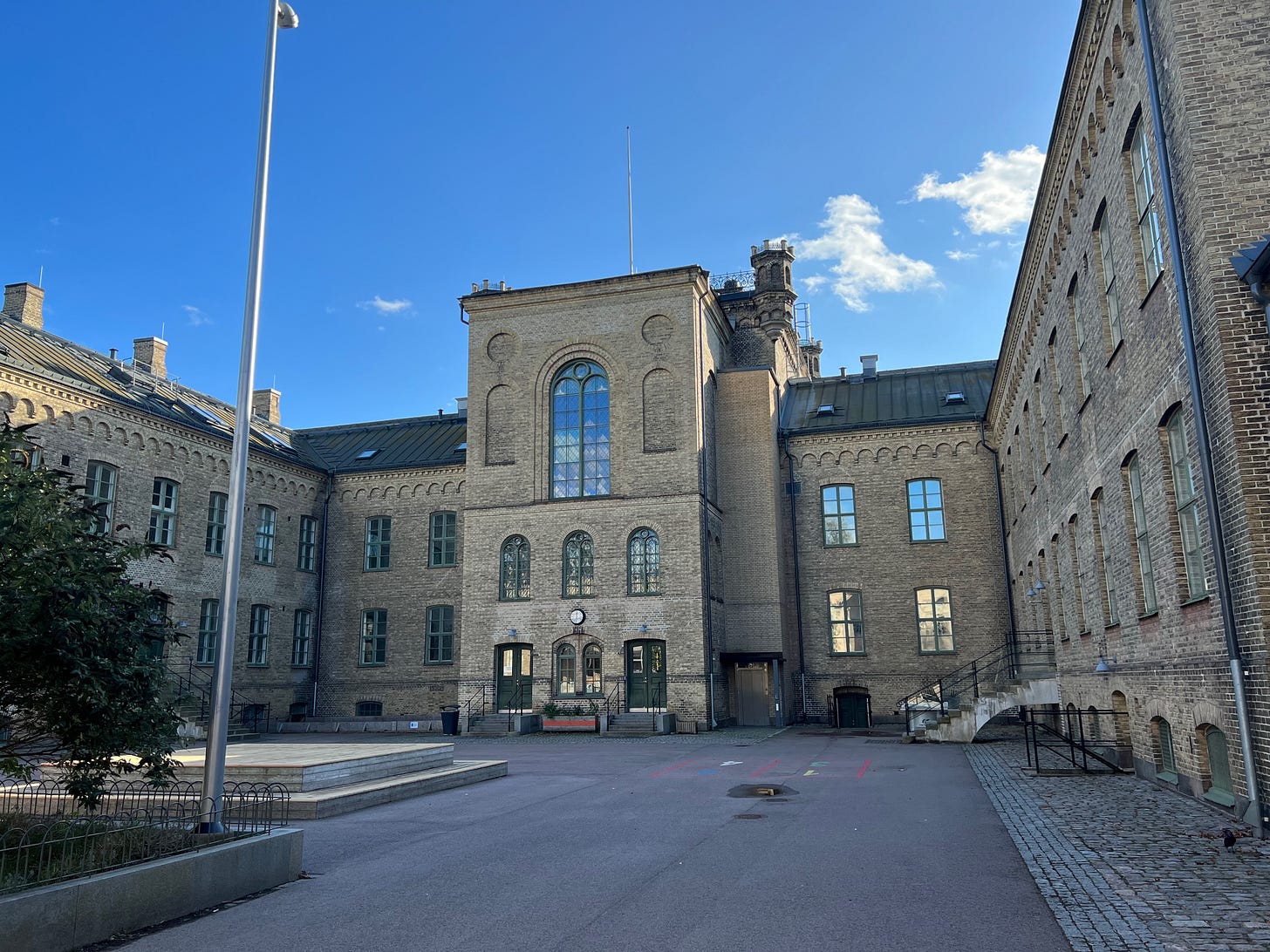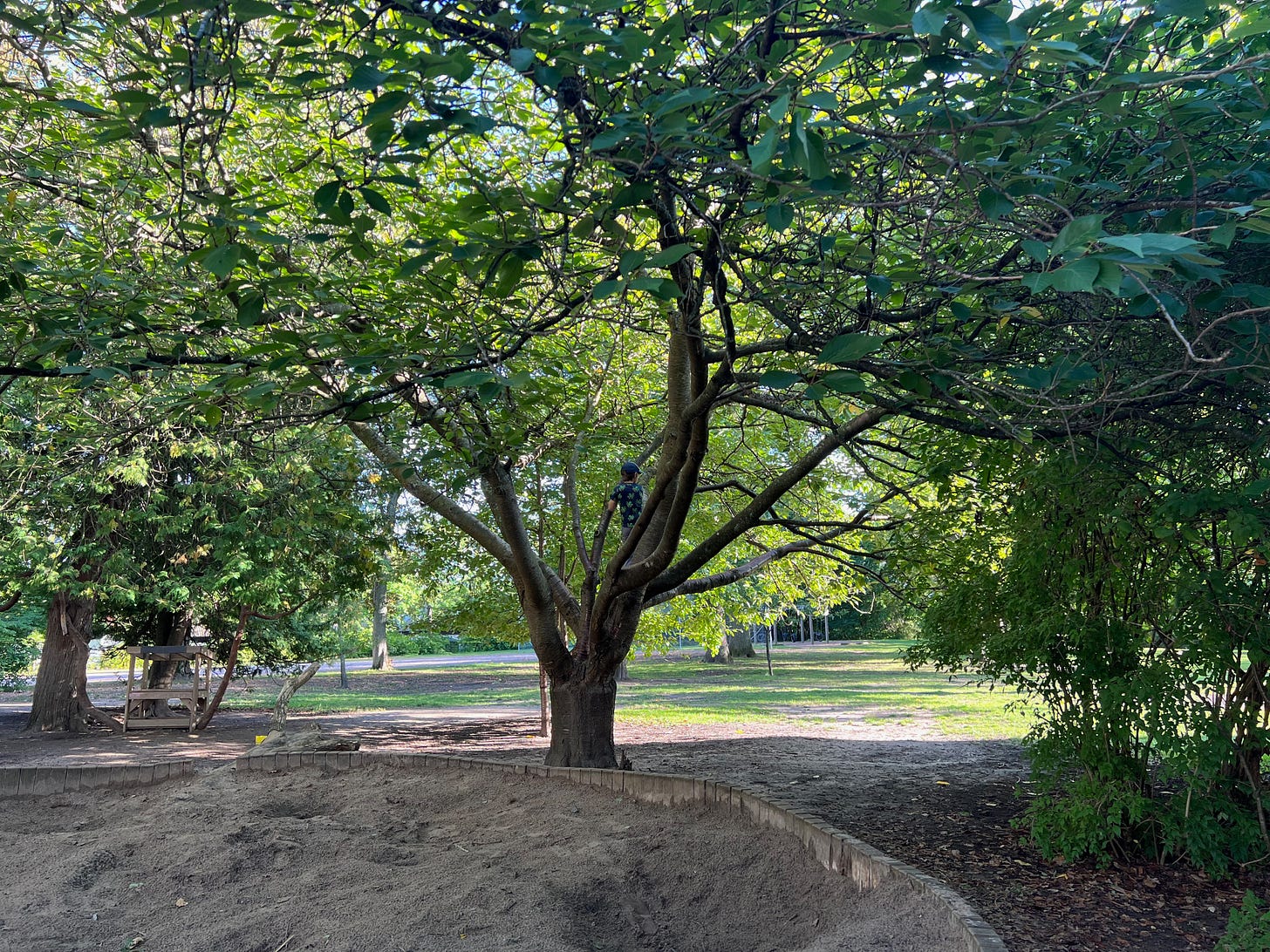As a parent and a student, I value education. While I am by no means an expert on the educational system, I value its importance as a product of strong educational institutions. As parents making a move half-way around the world, education was one of our most critical decisions. We researched as best we could from afar and since the move, we have continued to learn how the system works here in Sweden. This post is only informed by our own experience, and is not necessarily representative of the entire educational system. That said, knowing how often education choices and decisions come up for families – whether you move or not – it’s worth highlighting.
(mural at my children’s school in Sweden)
In Sweden, attending school is required for children from ages 6–16, at which point they can apply for upper secondary schools for the next three years. (Home schooling is not allowed.) In our research before moving, we learned that our children could enroll in either a Swedish or an international school. If we opted for a Swedish school, the municipality would place us into whatever school was available. For the international schools, we had to apply and meet specific criteria to be accepted. In either case, we would not pay any school fees, as the tuition is covered by tax dollars. (There are private schools in Sweden, but very few.)
(this school building dates back to 1871)
We chose to enroll our children in an international school that follows the International Baccalaureate (IB) curriculum, which places emphasis on developing intellectual curiosity and socio-emotional skills in students. Our kids are thriving in their new school, building relationships with teachers and students, and learning how to think through problems and solutions in a critical and constructive manner. Of course, I’m not in the classroom with them, so receive updates from the kids and their teachers on what they’re learning and how things are progressing. My impression is that the teachers also enjoy their work, and are funded to ensure students have the tools and equipment needed to best learn for their needs. All materials are provided by the school, including digital devices, as is their daily lunch, which the kids find tasty and satisfying (usually! On occasion, they have complained, but not very often). (Unlike the US, children aren’t allowed to bring in their own lunches.) Our youngest is also enrolled in after-school care (fritids) with pick-up as late at 17:30. After-school care has an additional cost, charged on a sliding scale; our cost totals about $100/month.
While our children are older, it’s worth noting the state-funded preschools (förskola) that are available for children aged 1 to 5 (until the age of one, one or both parents are off to be with the child thanks to the generous parental allowance policy that covers ~80% of salary for that first year). Preschool is not mandatory, but many children attend because both parents are working or studying. From what I observe as I walk past the many preschools in my neighborhood, the children spend a lot of time outdoors (regardless of weather), with engaging activities and significant support from adults. Access to quality preschool is one of the parts of the system I’m most impressed by. It’s also an area where I hope other countries can follow, as it has a significant impact on family dynamics beyond the school.
(outdoor grounds at the school in Sweden - lots of trees and places to explore)
Comparing my experiences in Sweden and the Bay Area, I fully acknowledge how different everyone’s experiences can be when it comes to childcare and school options. I share my experience as an n of one, knowing that it’s not representative of everyone. Because both L and I worked full-time, and wanted to continue doing so after our first child was born, finding care was essential. We lived in San Francisco at the time and were lucky enough to find two neighbors with whom we shared a nanny for the first year. After M turned one, we found a family-run daycare recommended by friends of ours. Both the nanny and the daycare were excellent, and our daughter was in good care. The costs were high, but this was the norm for where we lived. When we started to research primary school options, we discovered a much more challenging process. Though the unified public school system in San Francisco had many strengths, one of its biggest weaknesses was that many families ended up being placed in schools far from where they lived, and bus service was not always available. This resulted in many families enrolling their children in private school (more than 30 percent of children attend private school), or leaving San Francisco altogether. We were one of the families that decided to move – in our case, we moved across the Bay to be part of the Berkeley public school system.
We had mostly a positive experience in Berkeley, where our daughter was enrolled first at Thousand Oaks for Kindergarten before transferring to Sylvia Mendez the following year because the district moved all dual language programs to a single school (budget cuts). Teachers and staff at both schools worked hard to foster learning, development, and a strong sense of community. Our daughter thrived in the school and made strong friendships in her time there. Because budget constraints were ever present due to lack of public funding (even with Berkeley being unique with a special tax to support schools), the Parent Teacher Association would raise additional funds to enable the school to offer more activities, tools and equipment for everyone. It was also common for families to reach out to teachers to help pay for basic classroom supplies Otherwise, teachers would have to pay for them out of their own pocket. Budget constraints were real and they continue to be so today in the post-COVID aftermath as the cities and districts in the state figure out how to manage a volatile financial situation. I don’t envy those who are trying to make it all work for students and teachers alike, and I admire all my friends and community who continue to support the schools and their children’s education. It is a structural challenge that can be solved, albeit not easily when such vested interests and laws in California (hello, Prop 13) are firmly in place.
Beyond the school experience, aftercare is always another consideration for working families. While schools in the US oftentimes offer aftercare, they do have a cost associated. In our case, we had our kids bussed to a location closer to our home to ensure an easier pick-up. For comparison’s sake, we paid closer to $700/month for each child when we lived there (today, it is almost $1000/month for the same location).
If I had more expertise in education, I would also include comparisons on knowledge goals, curriculum, and performance. However, I do not hold that expertise, so merely share my experience as a parent who has now participated in two different nation’s school systems. While state budget support is a key point of difference, I also know that my children did well in California and they are doing well here in Sweden, too. There are pros and cons in any situation, and we’re fortunate to experience something new and different. I believe that education is a fundamental right, and it’s also the key to a country’s future. How countries, or states, fund that future, is a critical question. My hope is that more people will see the need to support our schools – and future generations – in the best way possible.







Thanks Shauna,
Big difference in approaches to family and child support. So happy your children flourished in each system. Look forward to more posts. JmP